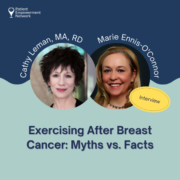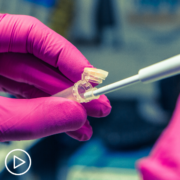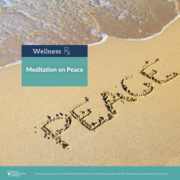Exercising After Breast Cancer: Myths vs. Facts
The benefits of physical activity for people who have undergone treatment for breast cancer are numerous, from reducing fatigue to helping regain a sense of well-being. However, as with diet recommendations, it can be confusing when it comes to how much exercise to take and the type of exercise that is safe during and after treatment.
Recently, I spoke with Cathy Leman, a registered dietitian, nutrition therapist, personal trainer, and survivor of hormone-positive breast cancer. Cathy shared many helpful tips and strategies for those who may be unsure where to start with an exercise routine after a diagnosis of breast cancer.
M.E.O’C.
What are some of the myths associated with exercise and breast cancer? When I had my surgery, I thought I shouldn’t lift anything heavy, such as weights. And that rest is the best way to heal. Are these beliefs true?
C.L.
The two thoughts you had are very common! Immediately post-surgery, there definitely are weight limitations in place, yet once your doctor removes exercise restrictions, and gives clearance, there are no limits (other than an individual’s physical ability) on how heavy one can lift. Exercise also helps restore mobility and range of motion after surgery, and there is research identifying exercise as a way to support healing. By the way, it’s important to ALWAYS get your doctor’s approval to add or increase exercise post-surgery.
M.E.O’C.
That’s wonderful to hear, Cathy. Let’s talk about the benefits of exercising now that we have been cleared to start.
C.L.
There are so many! Increased range of motion and improved mobility, reduction in fatigue, improvement in strength and stamina, and stress and anxiety management.
M.E.O’C.
What would you suggest to someone who feels intimidated by the current exercise guidelines, which recommend 150 minutes of exercise per week? You may feel exhausted from cancer treatment and this can seem like an overwhelming task.
C.L.
150 minutes per week translates to ~ 21 minutes per day. I recommend breaking that down even further, for example, 10 minutes of activity in the a.m. and 10 minutes of activity in the evening. Start small, with easy stretches and a walk around the block.
M.E.O’C.
I really like the idea of breaking exercise down into manageable chunks this way. Okay, let’s move on to where and how to exercise. Gym visits may not be an option for everyone, especially because many of us are still cautious about being in public spaces due to Covid. How can we replicate some of the traditional gym exercises at home?
C.L.
Body weight exercises like squats, lunges, modified push-ups and planks are great for building overall body strength. Walking or running outdoors offers great cardiovascular benefits. During inclement weather, dancing, walking up and down stairs, and using online in-home workouts are ways to keep moving, even without visiting the gym.
M.E.O’C.
Thanks Cathy for taking the time to talk to us about exercising in ways that are achievable and beneficial, and dispelling some of the common myths around exercise and breast cancer.
About Cathy Leman
Cathy is the founder of HEALTH REBUILD 365, a program that helps post-treatment survivors of hormone-positive breast cancer end food fear, stress, anxiety and guilt, and make confident diet decisions that minimize fear of recurrence.
She also writes the dam. mad. About BREAST CANCER blog, and speaks to groups and organizations about the power of nutrition and lifestyle to optimize survivor health.
www.cathyleman.com IG; @hormone.breastcancer.dietitian

A Stanford Medicine X e-Patient scholar, Marie Ennis O’Connor is an internationally recognized keynote speaker, writer, and consultant on global trends in patient engagement, digital health and participatory medicine. Marie’s work is informed by her passion for embedding the patient voice at the heart of healthcare values. She writes about the experience of transitioning from breast cancer patient to advocate on her award-winning blog Journeying Beyond Breast Cancer.










